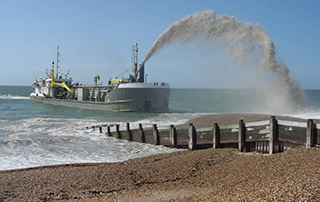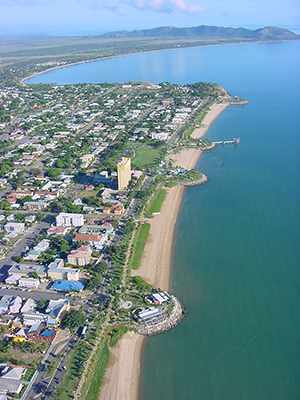 Over the years, our coastal engineers have been responsible for the successful delivery of beach nourishment projects at locations throughout Australia, South East Asia and the Pacific Region. But just what is beach nourishment?
Over the years, our coastal engineers have been responsible for the successful delivery of beach nourishment projects at locations throughout Australia, South East Asia and the Pacific Region. But just what is beach nourishment?
A strategy of beach nourishment entails the placement of sand directly onto a beach – either by using conventional earthmoving techniques or by pumping – so as to restore an adequate erosion buffer on the foreshore. The advantages of beach nourishment as an erosion management strategy are that it has virtually no adverse impacts on adjacent foreshores, and it maintains (or may even enhance) beach amenity.
It is generally regarded as being the most desirable solution to erosion problems on foreshores where a suitable and economic source of sand is available.
 A frequent community criticism of beach nourishment projects is that it does not provide a permanent solution to persistent long-term erosion problems – since it requires an on-going commitment to further renourishment. Nevertheless most other forms of direct intervention (even those of a “hard” structural nature such as rock seawalls) also require maintenance and a commitment to future costs. When all impacts and costs are taken into account, the requirement for future nourishment campaigns may not detract from the cost/benefit advantage of a beach nourishment strategy.
A frequent community criticism of beach nourishment projects is that it does not provide a permanent solution to persistent long-term erosion problems – since it requires an on-going commitment to further renourishment. Nevertheless most other forms of direct intervention (even those of a “hard” structural nature such as rock seawalls) also require maintenance and a commitment to future costs. When all impacts and costs are taken into account, the requirement for future nourishment campaigns may not detract from the cost/benefit advantage of a beach nourishment strategy.
However the ability to immediately replace sand lost in a storm so as to provide continual protection by an adequate buffer is often a challenging issue under this strategy. This is particularly the case given that there can be several storms or cyclones in any one season; which means that sand may need to be placed onto the beach more than once in any storm/cyclone season so as to be completely effective.
Sand used for nourishment is typically sourced from outside of the active beach system to offset any possibility that the benefit to the nourished foreshore is achieved at the expense of beach erosion elsewhere. This places a constraint on prompt restoration of buffers depleted by storm/cyclone events if such sources are not readily to hand.
 The requirements for an effective beach nourishment strategy are determined by the local sediment transport regime. The objectives of such a strategy are to establish and maintain adequate erosion buffers.
The requirements for an effective beach nourishment strategy are determined by the local sediment transport regime. The objectives of such a strategy are to establish and maintain adequate erosion buffers.
When considering a beach nourishment strategy, it is necessary to define a Coastal Defence Line which represents the landward limit of acceptable beach fluctuations. In other words, it forms the landward boundary of the sand buffer which is placed to protect the shoreline. Property and infrastructure landward of the Coastal Defence Line will remain protected throughout a particular planning period, whereas foreshore areas seawards of the line fall within the dynamic erosion buffer.
Local cross-shore sand transport processes dictate the overall volume of sand required in the buffer so as to accommodate a particular storm intensity. On the other hand, longshore transport processes determine the average rate at which sand needs to be added periodically to the buffers so that they are maintained in the long-term.
The buffer characteristics of sand volume and width are basically the volumes and widths that would be removed by severe storms.
An appropriate beach nourishment strategy would be to initially create the buffers required for present-day conditions and to then continually monitor foreshore performance – increasing buffer volumes/widths as actual climate change conditions manifest themselves.
Clearly beach nourishment can be a panacea for eroding beaches if appropriately planned, designed and implemented. But its success as a long-term solution to beach erosion problems requires very specialised skills. If considering such a strategy, you should talk to your friendly coastal engineer.










